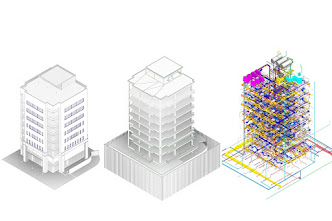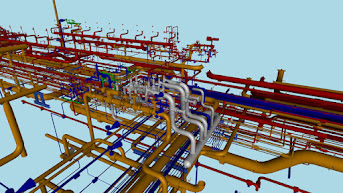Mastering the Game: The Latest Trends in MEP BIM Services - Silicon Valley
Welcome to Silicon Valley's blog post, where we delve into the fascinating world of MEP BIM services and explore the latest trends shaping the industry. In this article, we will not only provide valuable insights into the evolving landscape of BIM for MEP but also share the experiences of an experienced BIM modeler and their team, as they navigate through the challenges and advancements in MEP BIM modeling services. So, let's dive in and discover the exciting trends revolutionizing the game!
Embracing Collaboration and Integration:
One of the key trends in MEP BIM services is the increasing emphasis on collaboration and integration. As our BIM modeler recalls, seamless coordination between MEP disciplines is crucial for project success. With the integration of MEP BIM modeling services, teams can work together efficiently, minimizing conflicts, and optimizing project outcomes.
Automation and AI in MEP BIM Modeling:
The use of automation and AI technologies is rapidly transforming MEP BIM modeling. Our expert modeler shares their experience of leveraging intelligent tools that automate repetitive tasks, freeing up time for more critical decision-making processes. From clash detection to quantity takeoff, these advancements enhance accuracy and productivity in MEP BIM services.
Sustainable MEP Design and Analysis:
Sustainability is a rising concern in the construction industry, and MEP BIM services are at the forefront of promoting environmentally-friendly practices. The BIM modeler highlights the integration of energy analysis tools within the MEP BIM modeling process, enabling designers to optimize energy efficiency, reduce waste, and create greener building systems.
Virtual Reality (VR) and Augmented Reality (AR) in MEP BIM:
The integration of virtual reality and augmented reality technologies in MEP BIM services is revolutionizing project visualization and coordination. Our BIM modeler shares how these immersive technologies enable stakeholders to experience the building virtually, making informed decisions and identifying potential issues before construction even begins.
Prefabrication and Modularization:
Prefabrication and modularization have gained traction in the MEP industry, streamlining construction processes and improving project efficiency. Our BIM modeler explains how MEP BIM services facilitate the design and coordination of prefabricated components, reducing on-site labor and enhancing project schedules.
Enhanced Clash Detection and Coordination:
The BIM modeler reflects on the advancements in clash detection and coordination within MEP BIM services. With sophisticated software tools and streamlined workflows, potential clashes and conflicts among different MEP systems can be identified and resolved early in the design phase, saving time and minimizing costly rework during construction.
Cloud-Based Collaboration and Data Management:
Cloud technology has revolutionized the way teams collaborate and manage data in MEP BIM services. Our BIM modeler shares their experience of utilizing cloud-based platforms to facilitate real-time collaboration, centralize project information, and ensure seamless access to the most up-to-date project data from anywhere, enhancing productivity and communication among team members.
Parametric Design and Generative Modeling:
Parametric design and generative modeling techniques are empowering MEP BIM modelers to explore innovative design possibilities. The modeler describes how these tools allow for the creation of intelligent building components that can adapt and respond to specific project requirements, optimizing performance, and pushing the boundaries of design in MEP BIM services.
Data-Driven Decision Making:
The utilization of data analytics and visualization tools is becoming increasingly prevalent in MEP BIM services. Our BIM modeler highlights the significance of data-driven decision-making, where insights gained from analyzing project data enable informed choices regarding energy efficiency, system performance, and operational optimization.
Mobile Applications and Field BIM:
Mobile applications are transforming the way MEP BIM Services are implemented in the field. The modeler shares their experience of using mobile devices to access BIM models on-site, enabling real-time collaboration, issue tracking, and efficient communication between field personnel and the design team, ultimately enhancing project efficiency and reducing errors.
Blockchain for MEP BIM Services:
The BIM modeler discusses the emergence of blockchain technology in MEP BIM services. They explain how blockchain's decentralized and transparent nature can revolutionize data management, contract administration, and project collaboration, ensuring security, traceability, and trust among stakeholders involved in the MEP design and construction process.
Digital Twin Integration:
Digital twin technology is making waves in the MEP industry. The modeler shares their experience of integrating digital twins into MEP BIM services, enabling real-time monitoring, performance analysis, and predictive maintenance of MEP systems. By harnessing the power of digital twins, stakeholders can optimize building operations and enhance overall efficiency.
Laser Scanning and Reality Capture:
Laser scanning and reality capture techniques have become essential tools in MEP BIM services. The BIM modeler explains how these technologies facilitate accurate as-built documentation, enabling seamless integration of existing conditions into the BIM model. This streamlines retrofit and renovation projects, minimizing errors and improving project outcomes.
5D BIM: Beyond Geometry and Time:
Beyond the traditional 3D and 4D BIM, the modeler explores the concept of 5D BIM, which incorporates cost estimation and project scheduling into the MEP BIM services. They discuss how the integration of cost and schedule data enhances project planning, budgeting, and resource allocation, leading to improved cost control and project predictability.
Internet of Things (IoT) and Smart MEP Systems:
The IoT is transforming MEP BIM services by enabling the integration of smart sensors and devices into building systems. The BIM modeler shares their insights on how IoT technology is revolutionizing the management and control of MEP systems, enhancing energy efficiency, occupant comfort, and operational performance.
Resilient Design and Disaster Preparedness:
Resilient design and disaster preparedness have gained prominence in the MEP industry. The modeler discusses how MEP BIM services are evolving to incorporate measures for mitigating risks and ensuring the resilience of building systems in the face of natural disasters, climate change, and other unforeseen events.
As the landscape of MEP BIM services continues to evolve, staying abreast of the latest trends is essential for professionals seeking to excel in their field. From enhanced collaboration and automation to sustainable design and advanced technologies like VR/AR and generative modeling, the industry is witnessing a paradigm shift. By embracing these trends and incorporating them into their workflows, MEP BIM modelers and their teams can master the game, delivering exceptional results and pushing the boundaries of innovation in the world of construction.
The world of MEP BIM services is continuously evolving, driven by technological advancements and changing industry demands. By staying informed about the latest trends, such as blockchain integration, digital twin adoption, laser scanning, 5D BIM, IoT applications, and resilient design, MEP professionals can stay ahead of the game, deliver exceptional projects, and shape the future of the industry.
As the MEP industry continues to evolve, staying updated with the latest trends in MEP BIM services is crucial for professionals seeking to master the game. Through collaboration, automation, sustainability, VR/AR integration, and prefabrication, BIM for MEP opens up new possibilities for improved project outcomes and enhanced client satisfaction. By sharing experiences and knowledge, the BIM community can collectively embrace these trends and shape the future of MEP BIM modeling services.
Silicon Valley Infomedia Pvt. Ltd. is a global leader providing CAD-based BIM, architectural, and structural services, as well as web services and app development worldwide. With expertise in cutting-edge technologies, we deliver customized solutions to enhance project efficiency and accuracy. Contact us for innovative solutions in AEC and digital platforms.
Do Not Missout our WordPress blog series on the CAD and BIM process:



Comments
Post a Comment